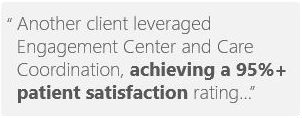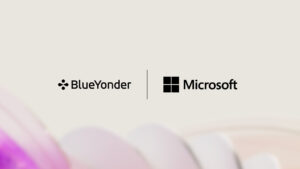
Building the bridge to personalized care
Tribridge, a Microsoft partner and leading technology company specializing in purpose-built healthcare solutions, has helped more than 300 healthcare organizations improve patient care, eliminate inefficiencies, and cut costs. Tribridge Health360 Engagement Center, built on Microsoft Cloud technology, is transforming care with a patient-centric, personalization at scale approach that dramatically enhances the patient experience. We sat down with Damon Auer, Vice President of Health and Life Sciences at Tribridge, and Rich Nero, Director of Healthcare Business Development at Tribridge, to learn more about how digital transformation is enabling organizations to revolutionize patient relationships and healthcare.
 Damon Auer, Vice President Health and Life Sciences, Tribridge Damon Auer, Vice President Health and Life Sciences, Tribridge |
 Rich Nero, Director of Healthcare Business Development, Tribridge Rich Nero, Director of Healthcare Business Development, Tribridge |
How has digital transformation challenged healthcare organizations?
Rich: Electronic Medical Records (EMR) were considered the center of digital transformation in healthcare. But the EMR was never very person or patient-centered – it was just a digital chart and there was little incentive or intent to personalize care experiences. As organizations started to mature and put the patient at the center of care, they realized that EMR systems are just one data source of many that are needed to get a complete picture of the patient. To succeed, providers need to know their consumers better – through EMR data, but also via patient preference, claims, marketing and other data sources. And they need all this data aggregated and accessible in one system, which is a big challenge. Plus, a static enterprise data warehouse is useless, so you must not only amalgamate data, but also leverage it to surface insights and enable collaboration and communication of those insights with care teams and patients.
 Damon: Another big challenge is that patient data is dispersed across many siloed systems. At any multi-hospital provider, there are dozens of systems at a minimum, some of which are electronic like EMR. But a large amount of patient data still exists on paper. I was just taking my kids in to get a checkup before summer camp and there were tons of physical forms! The breadth of what a healthcare organization institutionally knows about me as a patient is quite large, it’s just scattered all over the place. Knowing who I am, what my wellness goals are, what health issues I’m worried about, how satisfied I am with different members of my care team and such – that data is disconnected and dispersed. We knew there had to be a better way to make patient information more completely visible at every interaction. That’s why we built Health360 Engagement Center.
Damon: Another big challenge is that patient data is dispersed across many siloed systems. At any multi-hospital provider, there are dozens of systems at a minimum, some of which are electronic like EMR. But a large amount of patient data still exists on paper. I was just taking my kids in to get a checkup before summer camp and there were tons of physical forms! The breadth of what a healthcare organization institutionally knows about me as a patient is quite large, it’s just scattered all over the place. Knowing who I am, what my wellness goals are, what health issues I’m worried about, how satisfied I am with different members of my care team and such – that data is disconnected and dispersed. We knew there had to be a better way to make patient information more completely visible at every interaction. That’s why we built Health360 Engagement Center.
What is pushing providers to focus on the patent experience?
Rich: Today’s consumers are more savvy. Patients are starting to demand that their healthcare providers treat them like consumers – matching the personalized experience modern consumers receive in retail and other industries. And healthcare executives are stepping up, saying that they need to know their patients better, understand their preferences and learn how to serve them more effectively. Regulations are also a part of the equation, as patient satisfaction scores do impact providers’ bottom line, but the most important factor is that providers and payers know they must up their game to keep patients – or they will simply go to another hospital system nearby. When I spoke with healthcare execs 18 months ago, many didn’t even know what CRM (Customer Relationship Management) stood for. Now I have people reaching out to me asking for healthcare CRM solutions. And that’s what Engagement Center is all about, it transforms healthcare with a CRM system built to deliver personalized patient experiences.
How has the idea of patient-centric care and the idea of CRM in healthcare changed the patient experience?
Damon: Traditionally, going to the doctor’s office is like going to the DMV – it’s Groundhog Day as you repeat information and fill out the same forms. As a patient, if my healthcare provider has implemented a CRM solution like Engagement Center, I’m going to notice it immediately. When I walk in the door, communicate electronically, or give my provider a call, they instantly know who I am and what my preferences are. And they can take my personal preferences into account whenever they interact with me. It’s a significantly more personalized experience, as opposed to every encounter with my provider feeling like it’s the first time we’ve ever talked with each other.
How do providers make the delivery of care more patient-centric?
 Rich: Today, most healthcare organizations don’t have the necessary systems and tools in place to serve their patients better. We can tell our doctor that only appointments on Thursdays and Fridays work for us, or that we would like to receive test results via text. But truth be told, most providers can’t manage that basic data with their existing systems. We are now starting to see a huge shift to real CRM solutions like Engagement Center that enable providers to focus on the patient experience and achieve the level of personalization that they need.
Rich: Today, most healthcare organizations don’t have the necessary systems and tools in place to serve their patients better. We can tell our doctor that only appointments on Thursdays and Fridays work for us, or that we would like to receive test results via text. But truth be told, most providers can’t manage that basic data with their existing systems. We are now starting to see a huge shift to real CRM solutions like Engagement Center that enable providers to focus on the patient experience and achieve the level of personalization that they need.
Damon: Patients want to access care in ways that are convenient, consumable and beneficial for the consumer of care. It’s not just about cutting paperwork and adding telehealth or remote assistance systems, or knowing patients a little better. Providers face a physical transformation of the care system too. The data that is generated and captured with Engagement Center informs the workforce and physical capital is optimized, helping providers determine where to open new offices or clinics. To do that, healthcare organizations need to know who their patients are, where they are and what services they want.
Rich: Healthcare organizations want to improve more than just immediate care – they want to enhance long-term care management and increase the efficiency and efficacy of inbound and outbound call centers. But they can’t do any of this without first knowing their patients, bringing different data sources together and creating a positive environment for patient engagement. Healthcare organizations are on a journey and it starts with Engagement Center, with a CRM approach that empowers providers and patients to transform communication, collaboration and care.
How does Health360 Engagement Center help in delivering personalized care?
Rich: Engagement Center functions as a hub where EMR, claims, preferences and many other sources of data come together. Aggregating, analyzing, and sharing the right data back out to care teams empowers you to achieve many different provider and payer objectives, such as transforming care management or dramatically enhancing marketing. We have built powerful modules on top of Engagement Center, like Care Coordination, that enable tremendous innovation and efficiency in healthcare. Other partners in the Microsoft ecosystem are approaching us, asking if they can map to Engagement Center’s powerful patient data model. Solutions like Engagement Center are the foundation for the movement to the personalization of care, putting patients at the center of the healthcare system. Plus, we are very far ahead with our advanced modules like Care Coordination. We provide a clear path to help healthcare organizations get to the next level with powerful care systems for providers to grow into.
What kind of results have customers seen with Health360 Engagement Center?
 Rich: One of our customers has nearly 6 million patients in Health360 Engagement Center, bringing together data from clinical sources like EMR, claims, preferences and more. They collaborate and communicate tons of data daily with our solution, empowering care teams and staff with a “golden record” to know patients better. Another client leveraged Engagement Center and Care Coordination, achieving a 95%+ patient satisfaction rating through the powerfully personalized experiences enabled by our solution. That 95%+ number is very high for this business and it was a significant increase for our customer. Plus, they are seeing patients engage at a rate that is four times the national average, proving out a trend many of our customers have seen – as they get to know patients better, patients become more satisfied and engage more.
Rich: One of our customers has nearly 6 million patients in Health360 Engagement Center, bringing together data from clinical sources like EMR, claims, preferences and more. They collaborate and communicate tons of data daily with our solution, empowering care teams and staff with a “golden record” to know patients better. Another client leveraged Engagement Center and Care Coordination, achieving a 95%+ patient satisfaction rating through the powerfully personalized experiences enabled by our solution. That 95%+ number is very high for this business and it was a significant increase for our customer. Plus, they are seeing patients engage at a rate that is four times the national average, proving out a trend many of our customers have seen – as they get to know patients better, patients become more satisfied and engage more.
Why did you choose to partner with Microsoft?
Damon: Tribridge has had a fantastic, long-term relationship with Microsoft. When we looked at our opportunity to scale Health360 Engagement Center, with a vision to personalize care experiences for everyone, we realized that Microsoft was the best choice. To offer patient-centric care solutions globally, we needed both a scale of distribution and operational support for our customer that only a hyper-scale, enterprise cloud could provide. We also chose to partner with Microsoft because of the incredibly deep ecosystem of tools available in the Microsoft Cloud stack, including Office 365, Dynamics 365, and the many powerful Azure analytics modules we can bring to bear. Microsoft enables us to not only power our solutions today, but future-proof and prepare our solution for tomorrow. The cutting-edge cloud technology that we can enable is really pretty unique to Azure.
With all the uncertainty in healthcare, is now the right time for digital transformation?
Damon: One thing we know for sure is that we’re not going backwards. Healthcare is going to continue to get more consumer-centric, and that is awesome for us as patients and consumers. In this time of transformation and uncertainty in the industry, creating personalized patient experiences is a no-brainer. Betting on the Microsoft Cloud and Health360 Engagement Center as the foundation for that consumer transformation of healthcare is a low-risk, high-reward move.
Tribridge Health360 Engagement Center, built on Microsoft Cloud technology, is available now on Microsoft AppSource. Learn how Health360 Engagement Center transforms patient relationships, placing consumers at the center of care, by trying the solution today.




